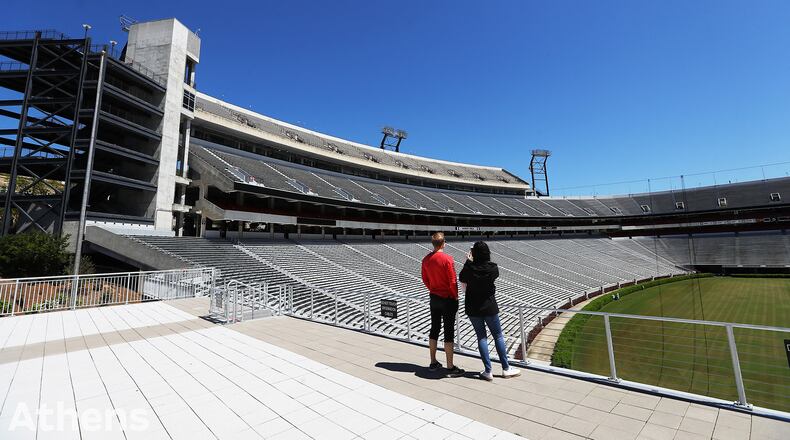There haven’t been any games at the University of Georgia for six months and won’t be for at least another seven weeks. Nevertheless, Claude Felton has stayed busy.
Among other things, the Georgia Bulldogs’ longtime sports communications director has been taking measurements. You don’t get to be a Hall of Famer in your vocation without paying attention to details, and Felton has been doing that. He and his staff are trying to determine exactly how many reporters and photographers could be in the press box of Sanford Stadium and along the sidelines of Vince Dooley Field while adhering to social-distancing guidelines of staying six feet apart.
“One thing’s for sure,” Felton said this week, “there’s going to be much fewer people in the press box and photographers on the field than there have been in the past. It’s going to be significantly less than what we’re used to.”
For Georgia games against opponents such as Notre Dame last year, there can be upward of 500 media members in Sanford Stadium. There might not be a quarter of that allowed this fall, if any at all.
All that’s still being worked out, but this is where we are with college football. Planning and hoping.
In the past week, the SEC has pressed forward with plans to play a conference-only, 10-game schedule that will commence Sept. 26. On Tuesday, it was determined that ongoing workouts could continue and that preseason camp, such as it is, can get under way Aug. 17.
The ACC, Big Ten, Big 12 and Pac-12 and likewise have announced their plans for playing football, or not, this fall.
None of that is, of course, a guarantee that it will happen. That will be dependent upon thwarting the continued progression of an unrelenting coronavirus pandemic. But what has been proved to date is the Power 5 is willing to do whatever it takes to play football this fall.
At UGA, the school reports a total of 441 confirmed cases of COVID-19 since March among its faculty, staff and students. The daily report, which is posted on the school’s website, does not differentiate between athletes and other groups.
The UGA Athletic Association has not responded to open-records requests for the number of confirmed cases specific to its athletes who were summoned to campus in June. UGA officials say it will respond eventually, but not until the 90-business-day grace period adopted by state law in 2016 for athletics-related information passes. That could be as late as November.
In the meantime, the SEC is pressing forward with fall athletics. The league is doing so with an eye on professional sports. To that end, the buzz word in the league currently is “bubble.”
The pro sports that have had the most success against the onslaught of COVID-19 outbreaks have been the NHL, MLS and the NBA. Those sports have sequestered their athletes in hotels and designated lodges where ingress and egress is controlled and monitored and player movements are meticulously traced.
In other words, “bubbles.”
Major League Baseball returned without similarly strict monitoring protocols, and there have been COVID-19 breakouts within some teams.
Georgia athletes have been effectively in a bubble since they were allowed to return to campus for voluntary workouts June 8. The underclassman football players are staying in dorms where no other students are currently housed. Upperclassmen are allowed to stay in off-campus housing, but they do so while having to report all their daily movements and interactions.
Players enter and exit the football facility in limited-numbered groups at staggered times. They are screened upon entry each day and are tested regularly and cleaning crews follow each group’s movements.
Men’s and women’s basketball players and women’s soccer and volleyball players joined the football players in that daily regimen in July while participating in preseason workouts at their respective facilities.
That has proved highly effective over the summer. However, there is a much concern internally about what might happen when the UGA student population returns to campus for face-to-face instruction Aug. 20. Students, who will be required to wear masks in all university facilities, already are trickling into Athens by the dozens to move into off-campus housing and resume jobs around town.
“We’re expecting a time-bomb to go off sometime after that,” one UGA employee said of students’ return.
Hence, UGA athletics’ adherence to the “bubble” philosophy and social-distancing guidelines.
What might that look like? To do play football, UGA would have to limit Sanford Stadium to 25 percent capacity for home games. If that is the case, that would be about 23,250 spectators per home game in the nearly-93,000-seat facility.
How tickets might be distributed is unclear. Georgia sold out of its allotment of 61,000 season tickets in April. However, that does not include 17,000 tickets that are reserved for students. Players’ families account for another 400 seats per game, as does the Redcoat Marching Band.
UGA has yet to inform season-ticket holders -- who have to make a minimum donation per ticket for the right to buy them – whether they will receive any. If it is determined by total giving (or “points,” as UGA calls it) only the top percentile will be able to attend. UGA is expected to refund money to those who don’t receive tickets or forward their contributions toward next season’s ticket allotment.
Meanwhile, plans are falling into place for the competitions themselves. The NCAA Playing Rules Oversight Panel adopted guidelines in late July that will expand the team areas on the sidelines by 20 yards to each 15-yard line. Only one captain from each team and one referee will permitted at midfield for the pregame coin toss. SEC teams will have to adhere to league disinfecting and cleaning protocols for their respective sidelines and equipment, which will be inspected by SEC designees. All helmets are expected to be fitted with face shields.
In soccer, players will be ejected and will have to serve a two-game penalty for spitting. In volleyball, the teams will remain on the same bench during the entire match rather than switch benches after each set. And so on.
UGA submitted a 225-page report to the Board of Regents earlier this summer on how game-day operations might work in football. That document included details such as cashless concession and parking, mandatory social distancing of six feet to be maintained at all times between parties and no tailgating.
In a video conference call with reporters last week, Georgia Athletic Director Greg McGarity declined to confirm exactly what parameters to expect beyond adhering to CDC social-distancing recommendations and doing everything they can to make people safe. He said the school’s plans will be revealed sometime after the SEC’s new 10-game schedule is announced. That should come by early next week.
“We’re going through the final pieces of that now,” McGarity said. “Once we release that, those that are able to come to our games can feel they are as safe as possible. That’s our charge.”
In the meantime, measurements are being taken and plans are being made.
About the Author
Keep Reading
The Latest
Featured

